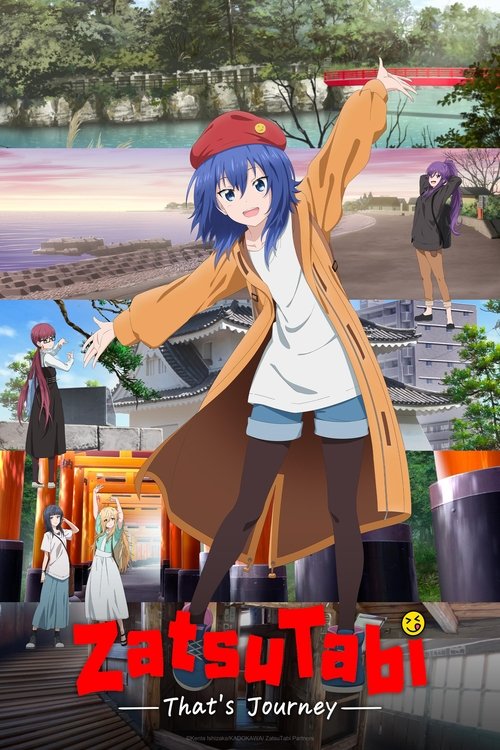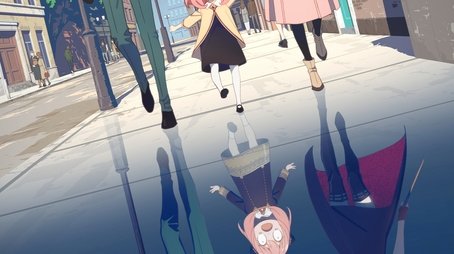
Ask Your Own Question
What is the plot?
Chika Suzugamori, an 18-year-old college student and rookie manga artist, begins the story having won a newcomer manga award but soon faces repeated rejection of her new manga drafts by her editor at Kadokawa publishing. Despite her initial success, she struggles with creative block and feels disheartened as her editor gently suggests she incorporate her hobbies or personal interests into her work, but Chika realizes she has none beyond manga itself.
One evening, while feeling down after another rejection, Chika watches a travel program on TV that inspires her to take a break and go on a trip. She impulsively posts a poll on her social media asking her followers where she should travel next. The next morning, she wakes to find that a senior colleague with a large following has shared her poll, causing it to go viral and making it impossible for her to back out. The public votes for her to travel north, and Chika commits to this spontaneous journey as a new hobby to find inspiration.
Chika sets off on her first trip to a quiet onsen (hot spring) town. She documents her experiences, including visiting a mountain shrine by hiking up stone steps through a forested path. The show highlights her interactions with the local environment, the peaceful atmosphere, and the small mistakes tourists often make, such as how to properly use the hot springs. Chika relaxes in the steamy hot spring waters, which are depicted as a moment of calm and rejuvenation rather than fan service.
After returning from her first trip, Chika continues to face challenges with her manga drafts, but whenever she feels down or blocked, she repeats the process of asking her followers to choose her next travel destination. Each trip is impromptu and based on the poll results, leading her to various lesser-known places that are not typical tourist spots. Throughout these journeys, she meets a few recurring characters, including a senior colleague with a vivid imagination and a big-sister-like figure who enjoys drinking, adding lighthearted moments to the otherwise calm and slice-of-life narrative.
As the series progresses, Chika's travels become a source of inspiration for her manga work. She learns useful everyday Japanese phrases and local dialects, which she sometimes incorporates into her stories. The show balances the depiction of real-world trivia about the places she visits with the gentle, healing atmosphere of her solo travels.
The final episodes showcase a photo montage of the various locations Chika has visited, emphasizing the beauty of ordinary places and the joy found in simple exploration. The series ends without dramatic climaxes or confrontations but with Chika continuing her journey of self-discovery and creative growth through travel, having found a new way to cope with her artistic struggles and life's uncertainties.
What is the ending?
The ending of ZatsuTabi -That's Journey- (2025) shows the main characters resolving their personal conflicts and finding inspiration through their travels, culminating in Chika successfully publishing a one-shot manga inspired by her experiences and the relationships she has built. The series closes on a hopeful note, emphasizing friendship, creative growth, and the joy of exploration.
Expanding on the ending scene by scene:
The final episodes focus on the reconciliation between Fuyune and Riri, two fellow mangaka who had a falling out earlier in the series. Their conflict is addressed through an apology manga that Riri creates, which serves as a heartfelt gesture to mend their friendship. This act of reconciliation is a key emotional moment, highlighting themes of forgiveness and understanding among the characters.
Meanwhile, Chika Suzugamori, the protagonist and struggling manga artist, draws inspiration from the events around her, including the subtle, borderline yuri moments between her friends. This inspiration fuels her creativity, leading her to complete a one-shot manga that is accepted for publication. This marks a significant milestone in her career, symbolizing her growth both as an artist and as a person.
Throughout these concluding episodes, the narrative continues to showcase the characters' journeys across various parts of Japan, emphasizing the beauty of travel and the small, meaningful experiences that come with it. The show maintains its slice-of-life tone, with detailed depictions of transportation, local culture, and the occasional travel mishap, such as missed reservations or wrong buses, which add realism and charm.
The final scenes depict the group enjoying a relaxed moment together, often around a hot spring, reinforcing their bonds and the comfort they find in each other's company. The series ends with a photo-like montage of their travels, capturing the essence of their journey and the memories they have created.
In terms of character fates:
- Chika achieves a breakthrough in her manga career, inspired by her travels and friendships.
- Fuyune and Riri reconcile and restore their friendship through honest communication and creative expression.
- Other friends like Koyomi and Yui continue to support Chika and share in the joy of exploration.
The ending does not present dramatic climaxes or major plot twists but rather a gentle, satisfying closure that reflects the show's focus on everyday life, personal growth, and the simple pleasures of traveling with friends. It leaves viewers with a sense of warmth and encouragement to find inspiration in their own journeys.
Is there a post-credit scene?
The TV show ZatsuTabi -That's Journey- (2025) does not have a post-credit scene. Available information from official episode guides and reviews does not mention any post-credit or after-credits scenes for this series. The show focuses on the protagonist Chika's travels and personal growth without additional scenes after the credits.
If you want, I can provide a detailed summary of the series or specific episodes.
What motivates Chika Suzugamori to start traveling instead of focusing on her manga drafts?
Chika Suzugamori begins traveling on a whim after facing repeated rejections of her manga drafts and feeling blocked creatively. Inspired by a TV program about traveling and encouraged by a social media poll that her followers and a senior colleague amplify, she decides to take a break from manga and embark on a journey without a specific goal, seeking new experiences to refresh her creativity.
How does Chika’s relationship with her editor influence her journey?
Chika's editor is supportive but honest about her drafts lacking a hook to engage readers. The editor suggests incorporating her hobbies into her work, but since Chika has no hobbies outside manga, this advice indirectly pushes her to explore new activities, leading to her decision to travel and find inspiration beyond her usual routine.
What specific locations does Chika visit during her travels in the series?
Chika's travels include a quiet onsen (hot spring) town and a hike up to a mountain shrine, featuring photorealistic depictions of forested pathways and serene natural settings that emphasize the slice-of-life and contemplative tone of the series.
How does social media play a role in Chika’s journey?
Social media is pivotal in Chika's decision-making process; she posts a poll asking followers which direction she should travel. A senior colleague with many followers reposts it, increasing public interest and commitment pressure, effectively turning her journey into a shared experience influenced by her online audience.
What internal struggles does Chika face throughout her journey?
Chika grapples with creative block, self-doubt, and the pressure of living up to her rookie manga award. Her journey reflects her search for personal fulfillment and inspiration beyond her work, as she confronts feelings of stagnation and the need to rediscover joy and meaning in both her art and life.
Is this family friendly?
ZatsuTabi -That's Journey- is generally family friendly with mild objectionable content. It is a slice-of-life, adventure, and comedy anime focusing on a young woman's travel experiences, with a soothing and lighthearted tone.
Potentially sensitive or objectionable aspects for children or sensitive viewers include:
- Mild sexual content: Occasional brief glimpses of cleavage and rare brief nudity in hot spring scenes, such as a bare butt, but nothing explicit or prolonged.
- Mild alcohol use: One adult character is shown drinking sake to excess on some occasions, which might be a concern for very young viewers or sensitive audiences.
- No violence, gore, profanity, or frightening scenes are present, making it safe from those perspectives.
Overall, the show's content is mild and suitable for older children and general audiences, but parents might want to be aware of the brief nudity and alcohol depiction before allowing very young or sensitive children to watch.
















